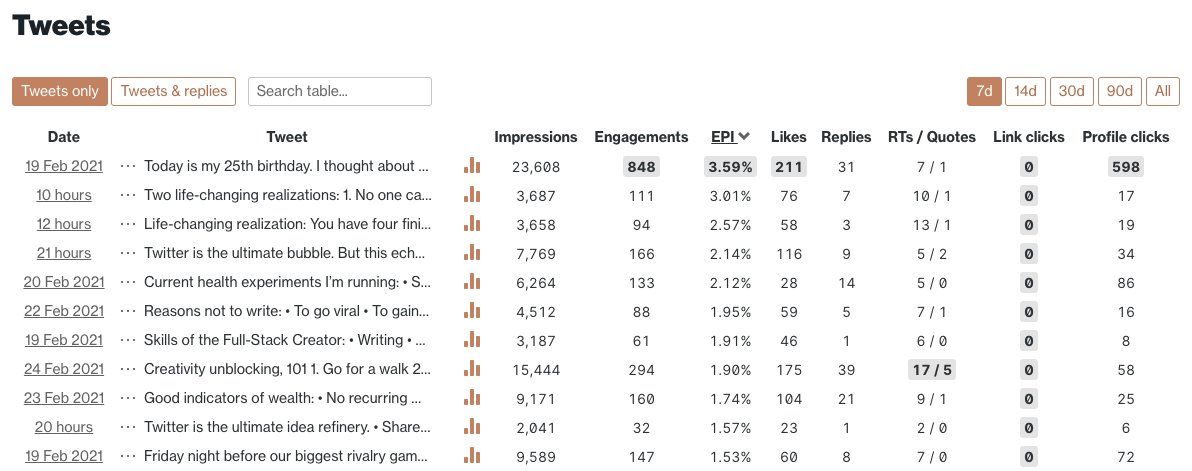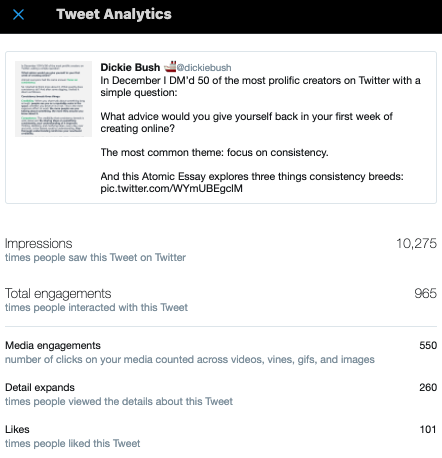Early writers approach online growth the wrong way.
They publish aimlessly, with ego, and with faulty assumptions.
But having tight, consistent feedback loops will accelerate your trajectory.
And here& #39;s how you can use a data-driven approach to do just that:
 https://abs.twimg.com/emoji/v2/... draggable="false" alt="🧵" title="Thread" aria-label="Emoji: Thread">
https://abs.twimg.com/emoji/v2/... draggable="false" alt="🧵" title="Thread" aria-label="Emoji: Thread"> https://abs.twimg.com/emoji/v2/... draggable="false" alt="👇🏼" title="Rückhand Zeigefinger nach unten (mittelheller Hautton)" aria-label="Emoji: Rückhand Zeigefinger nach unten (mittelheller Hautton)">
https://abs.twimg.com/emoji/v2/... draggable="false" alt="👇🏼" title="Rückhand Zeigefinger nach unten (mittelheller Hautton)" aria-label="Emoji: Rückhand Zeigefinger nach unten (mittelheller Hautton)">
They publish aimlessly, with ego, and with faulty assumptions.
But having tight, consistent feedback loops will accelerate your trajectory.
And here& #39;s how you can use a data-driven approach to do just that:
1/ Early writers make assumptions
You think you know what you want to write about.
And you think you know what people want to read.
But you have no data to back it up.
This leads to slow, loose feedback loops.
Instead, you want to make noise, then listen for signal.
You think you know what you want to write about.
And you think you know what people want to read.
But you have no data to back it up.
This leads to slow, loose feedback loops.
Instead, you want to make noise, then listen for signal.
2/ Twitter is the ultimate place to make noise
• Share an idea
• Measure the response
• Iterate, remix, and rewrite
With how quickly Twitter moves, no one remembers if you repeat yourself.
Zero downside, unlimited upside, and tight feedback loops all in one platform.
• Share an idea
• Measure the response
• Iterate, remix, and rewrite
With how quickly Twitter moves, no one remembers if you repeat yourself.
Zero downside, unlimited upside, and tight feedback loops all in one platform.
3/ Every tweet becomes a data point
Twitter& #39;s analytics allow you to measure the quality of the idea.
There are three measures to focus on:
• Impressions
• Engagements
• Engagements per impression
TLDR: how many people that saw your tweet engaged with it in some way
Twitter& #39;s analytics allow you to measure the quality of the idea.
There are three measures to focus on:
• Impressions
• Engagements
• Engagements per impression
TLDR: how many people that saw your tweet engaged with it in some way
4/ To start making noise, I tweeted 40x per week
At the end of every week, I used @dr& #39;s http://ilo.so"> http://ilo.so to find the ideas that resonated.
I would sort by EPI and add the top 10 ideas to a giant table.
At the end of the month, I had 40 "high-signal" ideas
At the end of every week, I used @dr& #39;s http://ilo.so"> http://ilo.so to find the ideas that resonated.
I would sort by EPI and add the top 10 ideas to a giant table.
At the end of the month, I had 40 "high-signal" ideas
5/ These 40 ideas created a pool of options
Here& #39;s what& #39;s important: they are just options.
You want to double down on the ones that not only resonated with others, but also resonated with you.
This is your sweet spot from which you can create prolifically and sustainably.
Here& #39;s what& #39;s important: they are just options.
You want to double down on the ones that not only resonated with others, but also resonated with you.
This is your sweet spot from which you can create prolifically and sustainably.
6/ Now, you tighten the lens.
Everyone wants to find their niche, but no one wants to repeat themselves.
You need to find a way to say the same idea in 20 different ways.
This means rewriting tweets, but also changing the medium.
Enter, Ship 30 for 30& #39;s Atomic Essay.
Everyone wants to find their niche, but no one wants to repeat themselves.
You need to find a way to say the same idea in 20 different ways.
This means rewriting tweets, but also changing the medium.
Enter, Ship 30 for 30& #39;s Atomic Essay.
7/ Atomic Essays are expanded tweets
Every essay I write starts as a tweet. Before putting effort into writing, I wait for the market& #39;s validation.
Good engagement on a tweet means an Atomic Essay should do well also.
I& #39;m listening for what the market wants, then delivering.
Every essay I write starts as a tweet. Before putting effort into writing, I wait for the market& #39;s validation.
Good engagement on a tweet means an Atomic Essay should do well also.
I& #39;m listening for what the market wants, then delivering.
8/ Here& #39;s an example:
I tweeted this idea on February 17th. It resonated heavily.
The next day, I turned it into an Atomic Essay, which also resonated heavily.
Noise -> signal -> double down.
https://twitter.com/dickiebush/status/1361849635560693760">https://twitter.com/dickiebus...
I tweeted this idea on February 17th. It resonated heavily.
The next day, I turned it into an Atomic Essay, which also resonated heavily.
Noise -> signal -> double down.
https://twitter.com/dickiebush/status/1361849635560693760">https://twitter.com/dickiebus...
9/ But the measurement continues.
Atomic Essays give me even more feedback.
I measure three things:
• Impressions
• Media engagements
• Likes
Then, I create two ratios:
• Media engagements per impression
• Likes per media engagement
These measure two different things.
Atomic Essays give me even more feedback.
I measure three things:
• Impressions
• Media engagements
• Likes
Then, I create two ratios:
• Media engagements per impression
• Likes per media engagement
These measure two different things.
10/ One measures copywriting skill, the other measures idea quality.
Media engagements per impression tell me how many people who saw my tweet read my essay.
This measures my copywriting ability.
From this data, I learn how to better grab attention and stop the scroll.
Media engagements per impression tell me how many people who saw my tweet read my essay.
This measures my copywriting ability.
From this data, I learn how to better grab attention and stop the scroll.
11/ The other measures idea and essay quality
Likes per media engagement tell me, of the people who read my essay, how many it resonated with.
From this data, I can analyze my essays and see which ideas resonated the most while also improving my writing skill.
Likes per media engagement tell me, of the people who read my essay, how many it resonated with.
From this data, I can analyze my essays and see which ideas resonated the most while also improving my writing skill.
12/ That& #39;s it!
No more flying blind with slow, loose feedback loops.
Using data and analytics is the new way to build an audience.
With data you can:
• Accelerate your audience building
• Learn to write more effectively
• No longer waste time due to faulty assumptions
No more flying blind with slow, loose feedback loops.
Using data and analytics is the new way to build an audience.
With data you can:
• Accelerate your audience building
• Learn to write more effectively
• No longer waste time due to faulty assumptions
If you want more frameworks like this, join Ship 30 for 30: http://Ship30for30.com"> http://Ship30for30.com
A bunch of people asking where to see tweet analytics.
1. https://analytics.twitter.com"> https://analytics.twitter.com has the basics
2. http://Ilo.so"> http://Ilo.so from @dr has the advanced features
 https://abs.twimg.com/emoji/v2/... draggable="false" alt="📈" title="Tabelle mit Aufwärtstrend" aria-label="Emoji: Tabelle mit Aufwärtstrend">
https://abs.twimg.com/emoji/v2/... draggable="false" alt="📈" title="Tabelle mit Aufwärtstrend" aria-label="Emoji: Tabelle mit Aufwärtstrend"> https://abs.twimg.com/emoji/v2/... draggable="false" alt="📊" title="Balkendiagramm" aria-label="Emoji: Balkendiagramm">
https://abs.twimg.com/emoji/v2/... draggable="false" alt="📊" title="Balkendiagramm" aria-label="Emoji: Balkendiagramm">
1. https://analytics.twitter.com"> https://analytics.twitter.com has the basics
2. http://Ilo.so"> http://Ilo.so from @dr has the advanced features

 Read on Twitter
Read on Twitter





